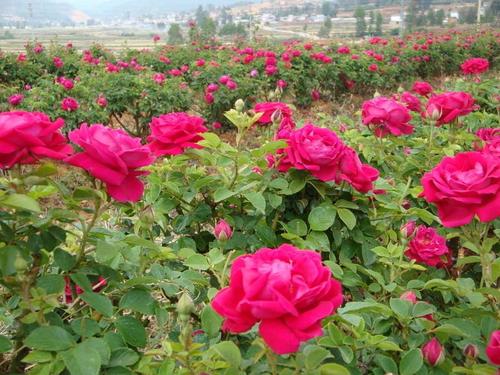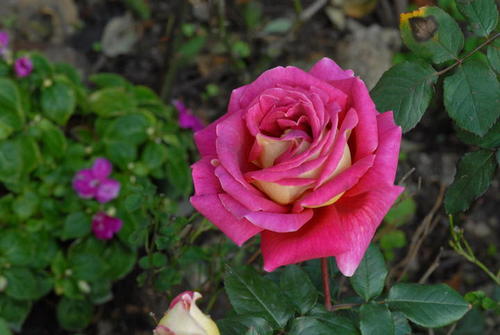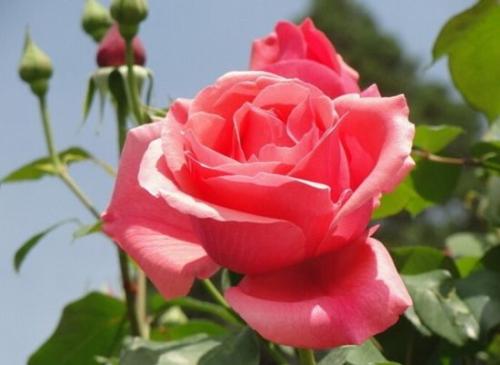Propagation methods of rose
Written by Maggie
Jan 11 2021

Roses is a flower every girl ikes. At the time of growing, a lot of people will want to propagate it, but the planting cycle is too long, so most of the friends are choosing cutting propagation. The following will introduce propagation methods of rose in detail.

1. Plant division propagation of rose
During the dormant period after falling leaves in autumn and before sprout in spring, rose bushes are dug up and divided into several small plants with one or two sprout sticks and two or three roots, which are planted in the rose cultivation land respectively to make them independent plants. In order to retain part of the mother, the plant thicket is not excavated when dividing, but a part of the plant thicket is chopped off to propagate a little.
2. Layered propagation of rose
① Horizontal layering propagation method
In the rose dormant period or growth period, in the mother plant next to the position to open a wide, deep about 10 centimeters of the ditch, 1 ~ 2 years of full and robust branches bend down all pressure into the ditch, only exposed branch tip, or the branch of a part of the pressure into the ditch, buried soil steadfast. Buried soil thickness with 8 ~ 10 cm is appropriate, and evenly spread on a phosphate fertilizer or barnyard manure. When the new shoot grows four leaves, cut off the tip at the lower part of the fourth leaf. When the roots grow well, they can be cut at the base and become independent plants from the mother.
② Chopping layering propagation method
Basically the same as the horizontal layering method, splitting branches is to cut the branches to be pressed into the soil in two halves, respectively pressed into the soil, germinate and take root, and then plant them in sections.
③ Bulldozing layering propagation method
After planting roses, when a few branches grow in the same year, pile loose soil with a thickness of 10 ~ 20 cm on the rhizosphere part, and then cut off the branches after the soil part takes root.Regardless of the type, the soil must be kept moist, or it will be difficult to root.

3. Cutting propagation method of rose
1) Thong method
When transplanting roses in the dormant period, cut the roots with a diameter of more than 0.5 cm and grow to 3 ~ 6 cm, insert the small head down into the breeding bed, cover it with soil of 2 ~ 3 cm, cover it with straw curtain or about 5 cm thick straw, and transplant it after sprout and root.
(2) Interpolation
It is divided into two kinds: tender branch cutting and hard branch cutting. Cut the rose shoot about 12 cm, the tip of the two leaves reserved, the following leaves even stalk cut off, cutting in the soil disinfection of the cuttage bed. Cover with a plastic small arched shed, and put up straw shade. Spray 1 ~ 2 times a day in the arch shed, and the cuttings after 7 days should be transplanted in time in the breeding bed, shading and sprinkling water. After 10 days or so to move to open ground growth. The survival rate of cuttings was the highest in mid-August and late August. Hard cuttings are generally biennial rose branches, each cut 15 ~ 20 cm long for a cuttings, in autumn after falling leaves before freezing, or after spring thawing, skew or grafted cuttings in breeding beds, cuttings depth above the surface exposed 1 ~ 2 buds is appropriate, after watering, keep the soil moist.
4. Buried strip propagation method of rose
In the deep ploughing base fertilizer in the propagation ground, every other 0.5 meters dig open 0.8 meters wide, 0.2 meters deep buried ditch, and then cut from the old rose plant bush on the old branches, without pruning, head and tail together tiled in the ditch bottom, at a soil thickness of 8 ~ 10 centimeters, practical, watering, cover grass about 3 centimeters. At the end of the autumn of the second year, seedlings can be dug and planted.
5. Grafting propagation method of rose
The grafting propagation method of rose is usually used as rootstock, whether bud grafting, grafting or root grafting, can obtain a higher survival rate, from cutting rose culture rootstock to grafting into seedlings, generally two years can be out of the garden.
6. Sowing propagation method of rose
Sowing propagation method of rose is mostly used to cultivate new varieties. Seeds collected in the autumn are planted in bags filled with wet sand soil, and then the bags are placed in an environment with a big temperature difference between day and night. After a month, the bags are transferred to a place around 20℃.

Latest Updated
- Benefits of Bugleweed - 7 Science-backed Health Benefits
- Bugleweed Dangers & Side Effects - Is It Poisonous?
- How to Plant Evergreen Trees - What You Should Know
- When to Plant Evergreens - Grow Guide for Evergreen Trees
- 12 Wonderful Evergreen Shrubs for Your Garden
- 12 Popular Evergreen Plants with Pictures for Beginners
- When And How To Prune A Lilac Bush Like a Pro
- How to Grow & Care for Lilac Vine (Hardenbergia Violacea)
- Japanese Lilac Tree (Syringa Reticulata) Care & Propagation Guide
- Shumard Oak Pros and Cons - What to Know
Popular Articles
- Winter maintenance of Antirrhinum Majus
- How to Grow Terminalia Mantaly Tree
- How to Grow and Care for Crossostephium Chinense
- How to grow Antirrhinum Majus in spring
- Peristeria Elata (Dove Orchid) Profile: Info & Care Guide
- Underwatered Snake Plant (Sansevieria Trifasciata) - Signs And How To Fix
- How to Care for Brazilian Jasmine Plant (Mandevilla Sanderi)
- How to Grow & Care for Graptopetalum Purple Delight in Summer
- Rosa Chinensis (China Rose): Plant Growing & Care Tips
- How to Care for Baby Sun Rose (Aptenia Cordifolia)